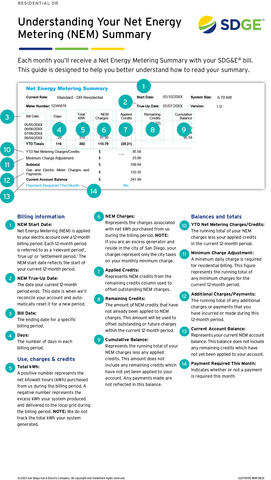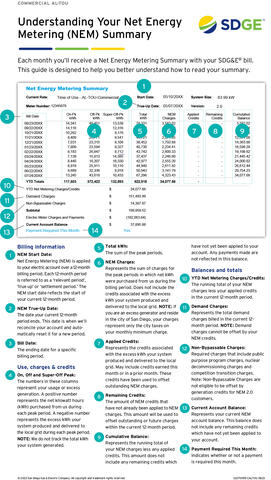Understanding Your NEM Bill

How to Read Your NEM Bill
As a Net Energy Metering customer, you receive a NEM summary on your SDG&E bill. Your bill contains charges for electricity you use from the grid, minus any available credit you’ve earned for excess energy your system produced. This means you’ll either have a positive or negative balance. Even if your system has generated more energy than you used from the grid, you may still owe a balance for fixed charges and fees that can’t be offset with generation credit.
The images below contain helpful information about how to read and understand the different sections of your NEM bill. Click to enlarge a PDF version.
As a residential NEM customer, you can pay your bill in full each month, but you also have the option to pay only part of your bill. If you’d like to take advantage of paying your NEM bill annually, be sure to turn off automatic payments. By paying annually, you may see that you build up a balance in the winter months, when you’re likely to use more energy from the grid because your system is taking in less sunlight and producing less electricity. Then, in the summer months, you may earn generation credits to apply to your balance on your annual true-up bill.
VNM, commercial and NEM Aggregation customers pay their NEM bill in full each month.
At the end of every 12-month cycle, we send an annual “true-up” statement. This is when any outstanding balance you owe for the year is due. Because your NEM bill balance can be positive or negative month to month, depending on your usage and the output of your renewable system, the “true-up” process is a simple way to zero out your balance annually. If you generated more energy than you used, we’ll retroactively apply that to any months you owed a balance. Your generation credits reset to zero at the beginning of a new 12-month cycle.
There are a few reasons you’ll still owe a balance on your bill. The most common reason is that your system is producing less energy than you’re using. When this happens, any generation credits you earn when your system overproduces may not completely offset your energy use from the grid. For example, at night you are using electricity from the grid when solar panels aren’t producing energy. If you’re using more than your system produces, you’ll still owe for the difference.
Additionally, there are required charges on your bill that can’t be offset by excess generation. State, taxes and other charges are collected on behalf of local and state government, including city franchise fees and state-mandated public purpose programs like wildfire fund and energy efficiency programs.
Your NEM generation credits are calculated according to the surplus energy your renewable system feeds back into the grid. We’ll provide a credit for the wholesale value of that energy on your monthly bill to offset your bill total. If you have more credits than you owe, your credits will roll over to the following month until your annual true-up bill.
Energy credits will be carried forward from month to month until the end of each 12-month cycle. At that time, you will receive a true-up bill to determine if you have a balance due. At that point, any unused credits will not be carried to the next 12-month period. To maximize your credits, make sure to monitor your usage throughout the year.
NEM Bill Terms and Definitions
Start Date: Net Energy Metering (NEM) is applied to your electric account over a 12-month billing period. Each 12-month period is referred to as a "Relevant Period". It is also referred to as your "True-Up" or "Settlement Period". The start date reflects the start of your current period.
True-Up Date: The date your current period ends. This date, also known as your NEM anniversary or settlement date, is when SDG&E will reconcile your account and automatically reset your account for a new period.
Total kWh: The net kWh for each billing period.
NEM Charges: Represents the charges associated with the net kWh purchased from SDG&E during the billing period.
NEM Credits: Represents the credits associated with the net kWh over-generated by your system and delivered to the local energy grid during the billing period.
Discounts: Any discount or California Climate Credit received in a given month.
Applied Credits: Any generation credits that have been applied to your account. Generation credits are used to offset outstanding net metering charges.
Remaining Credits: Credits that can be used to offset charges within the current True-Up period. These credits are calculated using the full retail rate for energy. This retail value is only applicable to offset charges for energy within your True-Up period. At True-Up, any remaining excess generation will be purchased by SDG&E at the wholesale rate.
Cumulative Balance: Represents the running total of your NEM charges and any applied credits. It is important to note, that this does not include any remaining credits, which have not yet been applied to your account.
YTD Net Metering Charges/Credits: The running total of the net metering charges and credits for the current "Relevant Period". This amount reflects your total net energy metering charges/credits and the total applied generation credits (NEM Charges + Applied Credits).
California Climate Credit: Represents the YTD California Climate Credit. This credit is part of California’s efforts to fight climate change and is designed to help utility customers during the transition to a low-carbon future.
Minimum Charge Adjustment: The running total of any applicable minimum charges for the current "Relevant Period". If you are a net generator for the year, these basic service fees and any applicable taxes will represent all you have to pay.
Excess Generation Payment: Represents any excess generation payments at the time of your True-Up. If your total kWh is a negative number in the YTD Totals, you will receive an excess generation payment as a credit on your bill. Payment is based on a rolling 12-month average of spot market prices. If your total kWh does not reflect a negative number, then you do not qualify for a payment.
Additional Charges/Payments: The running total of any other charges or credits on this account, such as charges related to your gas service or payments that you have made during this "Relevant Period".
Current Account Balance: Represents your current net metering account balance.
Payment Required This Month: Indicates whether or not a payment is required this month.
Base Services Charge: All residential customers, including those with rooftop solar, will transition to the Base Services Charge. Solar customers rely on infrastructure to draw electricity from the grid and send electricity back to the grid throughout the day to balance their usage with intermittent solar production. Additionally, they need grid support to meet energy needs during nighttime or when solar panels are not generating power.





